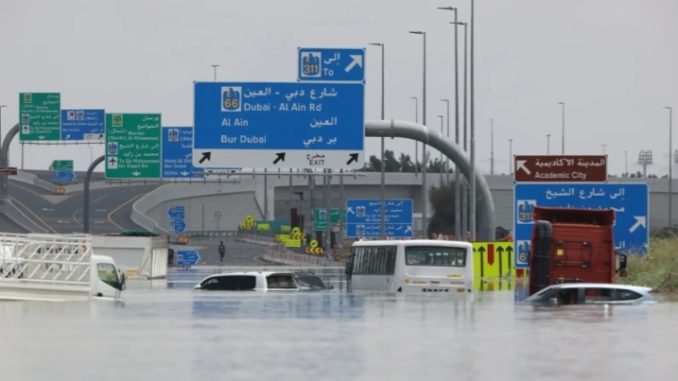The Arabian peninsula was hit by unprecedented rainfall and floods, shutting schools and grounding flights on Wednesday, with parts of the desert nation United Arab Emirates (UAE) receiving 10 inches of rain in 24 hours.
In Oman, at least 18 people have died in recent days because of the severe weather, the country’s National Committee for Emergency Management said.
The storms swamped roadways and created dangerous conditions across the region, a normally arid part of the world that is unaccustomed to intense rain and flash flooding.
Dubai’s airport advised passengers early Wednesday not to travel to the airport unless “absolutely necessary.” Major airline Emirates said in a post on X it was suspending check-in for all passengers in Dubai until midnight Wednesday (3 p.m. ET).
ALSO READ: Dubai creates own ‘rain’ to beat 122F heat
The National Center of Meteorology in Abu Dhabi said the rain in the UAE surpassed anything since records began in 1949 when the area was still a British protectorate and before the discovery of oil.
The Khatm Al Shakla area outside the city of Al Ain, near the border with Oman, received 10 inches of rain in less than 24 hours.
The meteorology centre called it “an exceptional event in the UAE’s climate history since the start of recording climate data, and it is expected that the coming hours will witness the recording of larger amounts of rainfall.”
Video obtained by Saudi Arabia’s state-owned news outlet Al Arabiya showed the tarmac in Dubai inundated, with aeroplanes skimming through floodwaters and support vehicles nearly submerged.
By midnight Tuesday, 5.59 inches of rain had fallen on Dubai over 24 hours — on average, 3.73 inches falls every year on Dubai Airport, a major hub for travel in the Middle East and beyond.
The UAE’s National Emergency Crisis and Disaster Management Authority urged people to stay home, saying on X that cars should be parked in “safe and elevated locations,” away from flood-prone areas and places where water can accumulate.
Private schools across the UAE were closed ahead of the storm, and government employees were instructed to work remotely.
The UAE is known for its dry conditions and arid climate, but it can get occasional precipitation in the winter.
In neighbouring Oman, storms and heavy rain in recent days killed 10 schoolchildren and an adult driver in a vehicle that was overtaken by floodwaters, according to the AP.
Other parts of the Middle East, including Qatar and Saudi Arabia, were also hit by unusually wet conditions this week.
It’s too soon to know whether global warming played a role in the recent storms, but studies have shown that a warmer atmosphere due to climate change can hold more moisture, which in turn can fuel more severe storms and intense rain.
Photographers captured dramatic images of cars submerged in floodwaters.
The deluge was also deadly. A 70-year-old man died after flooding swept away his vehicle in Ras Al-Khaimah, police said, and at least 18 people were killed in nearby Oman.
Extreme rainfall events are becoming more and more common due to climate change, which has increased the amount of moisture in the atmosphere, helping intensify the downpours.







Be First to Comment